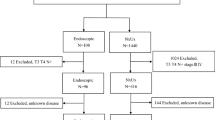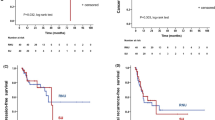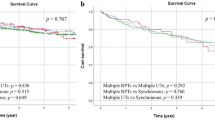Abstract
The traditional treatment for upper tract transitional cell carcinoma (UTTCC) consists of radical nephroureterectomy. A more conservative approach, however, was required in cases of bilateral UTTCC and in patients with disease in a solitary kidney but who had underlying comorbidities that made them unsuitable candidates for open surgery. Minimally invasive treatment methods were developed for these select groups of patients. Because of technological advancements and refinement in endoscopic techniques, most patients with UTTCC, even those with normal contralateral kidneys, can now be offered minimally invasive treatment with single or multimodal approaches involving ureteroscopy or percutaneous resection. For patients with low-stage, low-grade UTTCC, five-year survival rates are comparable for those treated endourologically and those treated by nephroureterectomy. High-grade lesions have much higher recurrence and progression rates than lower-grade lesions, and nephroureterectomy is therefore recommended in patients with high-grade disease. The use of adjuvant instillation in the treatment of UTTCC, administered via antegrade and retrograde methods, has been shown to improve outcomes. For recurrences to be diagnosed and treated in a timely manner, and acceptable cancer-free survival rates maintained, long-term rigorous follow-up after endourologic treatment, with regular surveillance ureteroscopy, is crucial.
This is a preview of subscription content, access via your institution
Access options
Subscribe to this journal
Receive 12 print issues and online access
$209.00 per year
only $17.42 per issue
Buy this article
- Purchase on Springer Link
- Instant access to full article PDF
Prices may be subject to local taxes which are calculated during checkout
Similar content being viewed by others
References
Fraley EE (1978) Cancer of the renal pelvis. In Genitourinary Cancer, 134 (Eds Skinner DG and deKernion JB) Philadelphia: WB Saunders
Keeley FX et al. (1997) Ureteroscopic treatment and surveillance of upper urinary tract transitional cell carcinoma. J Urol 157: 1560–1565
Anderstrom C et al. (1989) Carcinoma of the ureter: a clinicopathologic study of 49 cases. J Urol 124: 23
Strong DW et al. (1976) The ureteral stump after nephroureterectomy. J Urol 115: 654–655
Huffman JL et al. (1985) Endoscopic diagnosis and treatment of upper tract urothelial tumors. A preliminary report. Cancer 55: 1422–1428
Streem SB and Pontes EJ (1986) Percutaneous management of upper tract transitional cell carcinoma. J Urol 135: 773–775
Keeley FX et al. (1997) Diagnostic accuracy of ureteroscopic biopsy in upper tract transitional cell carcinoma. J Urol 157: 33–37
Chen GL and Bagley DH (2001) Ureteroscopic surgery for upper tract transitional cell carcinoma: complications and management. J Endourol 15: 399–404
Abdel-Razzak OM et al. (1994) Ureteroscopic biopsy in the upper urinary tract. Urology 44: 451–457
Daneshmand S et al. (2003) Endoscopic management of upper urinary, tract transitional cell carcinoma: Long-term experience. Cancer 98: 55–60
Elliott DS et al. (1996) Long-term follow up of endoscopically treated upper urinary tract transitional cell carcinoma. Urology 47: 819–825
Tasca A et al. (1992) Endourologic treatment of transitional cell carcinoma of the upper urinary tract. J Endourol 6: 253–256
Carson CC (1991) Endoscopic treatment of upper and lower urinary tract lesions using lasers. Sem Urol 9: 185–191
Schilling A et al. (1986) Use of the neodyrnium-YAG laser in the treatment of ureteral tumors and urethral condylomata acuminata. Clinical experience. Eur Urol 12 (Suppl 1): S30–S33
Malloy TR et al. (1986) Renal preservation utilizing neodymium:YAG laser. Urology 27: 99–103
Bagley DH (2001) Laser treatment of urothelial tumors. In Endourologic use of the holmium laser, 29–36 (Eds Bagley DH and Das AK) Jackson (WY): Teton NewMedia
Johnson DE (1994) Use of the holmium:YAG laser for treatment of superficial bladder carcinoma. Lasers Surg Med 14: 213–218
Razvi HA et al. (1995) Soft-tissue applications of the holmium:YAG laser in urology. J Endourol 9: 387–390
Bagley DH and Erhard M (1995) Use of the holmium laser in the upper urinary tract. Tech Urol 1: 25–30
Bagley DH et al. (1985) Endoscopic diagnosis and treatment of upper tract urothelial tumors—a preliminary report. Cancer 55: 1422–1428
Palou J et al. (2004) Percutaneous nephroscopic management of upper urinary tract transitional cell carcinoma: recurrence and long-term followup. J Urol 172: 66–69
Jarrett TW et al. (1995) Percutaneous management of transitional cell carcinoma of the renal collecting system: 9-year experience. J Urol 154: 1629–1635
Clark PE et al. (1999) 13-year experience with percutaneous management of upper tract transitional cell carcinoma. J Urol 161: 772–776
Jabbour ME et al. (2000) Percutaneous management of grade II upper urinary tract transitional cell carcinoma: the long-term outcome. J Urol 163: 1105–1107
Liatsikos EN et al. (2001) Transitional-cell carcinoma of the renal pelvis: ureteroscopic and percutaneous approach. J Endourol 5: 377–383
Patel A et al. (1996) Long-term outcome after percutaneous treatment of transitional cell carcinoma of the renal pelvis. J Urol 155: 868–874
Plancke HR et al. (1995) Percutaneous endoscopic treatment of urothelial tumours of the renal pelvis. Br J Urol 75: 736–739
Lee BR et al. (1999) 13-year survival comparison of percutaneous and open nephroureterectomy approaches for management of transitional cell carcinoma of renal collecting system: Equivalent outcomes. J Endourol 13: 289–294
Martinez-Pineiro JA et al. (1996) Endourological treatment of upper tract urothelial carcinomas: analysis of a series of 59 tumors. J Urol 156: 377–385
Jabbour ME and Smith AD (2000) Primary percutaneous approach to upper urinary tract transitional cell carcinoma. Urol Clin N Am 27: 739–750
Guinan P (1992) Renal pelvic cancer: a review of 611 patients treated in Illinois 1975–1985. J Urol 40: 393–399
Shelley MD et al. (2001) A systematic review of intravesical bacillus Calmette–Guérin plus transurethral resection vs. transurethral resection alone in Ta and T1 bladder cancer. BJU Int 88: 209–216
Herr HW (1985) Durable response of a carcinoma in situ of the renal pelvis to topical bacillus Calmette–Guérin. J Urol 134: 531–532
Irie A et al. (2002) Intravesical instillation of bacille Calmette–Guérin for carcinoma in situ of the urothelium involving the upper urinary tract using vesicoureteral reflux created by a double-pigtail catheter. Urology 59: 53–57
Patel A and Fuchs GJ (1998) New techniques for the administration of topical adjuvant therapy after endoscopic ablation of upper urinary tract transitional cell carcinoma. J Urol 159: 71–75
Thalmann GN et al. (2002) Long term experience with bacillus Calmette–Guérin therapy of upper urinary tract transitional cell carcinoma in patients not eligible for surgery. J Urol 168: 1381–1385
Oefelein MG and MacLennan G (2003) Transitional cell carcinoma recurrence in the nephrostomy tract after percutaneous resection. J Urol 170: 521
Huang A et al. (1995) Nephrostomy tract tumor seeding following percutaneous manipulation of a ureteral carcinoma. J Urol 153: 1041–1042
Schoenberg MP et al. (1991) The management of transitional cell carcinoma in solitary renal units. J Urol 146: 700–703
Okubo K et al. (2001) Intrarenal bacillus Calmette–Guérin therapy for carcinoma in situ of the upper urinary tract: long term follow-up and natural course in cases of failure. BJU Int 88: 343–347
Hayashida Y et al. (2004) Long-term effects of bacillus Calmette–Guérin perfusion therapy for treatment of transitional cell carcinoma in situ of the upper urinary tract. Urology 63: 1084–1088
Nadler RB et al. (1994) Durability of the tumor-free response for intravesical bacillus Calmette–Guérin therapy. J Urol 152: 367
Author information
Authors and Affiliations
Corresponding author
Ethics declarations
Competing interests
The authors declare no competing financial interests.
Rights and permissions
About this article
Cite this article
Ost, M., VanderBrink, B., Lee, B. et al. Endourologic treatment of upper urinary tract transitional cell carcinoma. Nat Rev Urol 2, 376–383 (2005). https://doi.org/10.1038/ncpuro0250
Received:
Accepted:
Issue Date:
DOI: https://doi.org/10.1038/ncpuro0250



